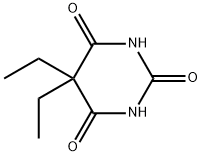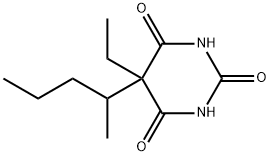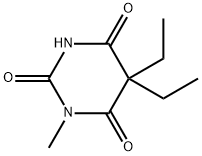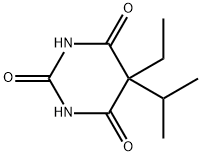BARBITAL
- CAS NO.:57-44-3
- Empirical Formula: C8H12N2O3
- Molecular Weight: 184.19
- MDL number: MFCD00036212
- EINECS: 200-331-2
- SAFETY DATA SHEET (SDS)
- Update Date: 2025-01-27 09:38:02

What is BARBITAL?
Description
Barbital is an analytical reference material that is categorized as a barbiturate. It acts as an agonist at GABAA receptors to induce central nervous system depression. Formulations containing barbital have been used as a sedative to treat insomnia and seizures in human and veterinary medicine. Barbital is regulated as a Schedule IV compound in the United States. This product is intended for research and forensic applications.
Description
Barbital (CRM) (Item No. 22854) is a certified reference material categorized as a barbiturate. Barbital is regulated as a Schedule IV compound in the United States. Barbital (CRM) (Item No. 22854) is provided as a DEA exempt preparation. This product is intended for research and forensic applications.
Chemical properties
White crystals or powder; bitter taste; odorless. Stable in air. Soluble in hot water, alcohol, ether, acetone, and ethyl acetate.
The Uses of BARBITAL
Prototype of the barbiturate hypnotics.
Definition
ChEBI: A member of the class of barbiturates, the structure of which is that of barbituric acid substituted at C-5 by two ethyl groups. Formerly used as a hypnotic (sleeping aid).
brand name
Dormileno;Escoderm;Hypnogene;Hypnox;Lidor;Megal;Plexonal;Somnytic tablets;Verinogen;Verodon;Veroletten;Verolitten;Veronigen.
World Health Organization (WHO)
Barbital is a long-acting barbiturate which is controlled under Schedule IV of the 1971 Convention on Psychotropic Substances. See WHO comment for barbiturates. (Reference: (UNCPS4) United Nations Convention on Psychotropic Substances (IV), , , 1971)
Safety Profile
Poison by ingestion, intravenous,intraperitoneal, and subcutaneous routes. Ingestion causespsychological effects in humans. Mutation data reported.When heated to decomposition it emits toxic fumes ofNOx. An hypnotic andsedative.
Purification Methods
Crystallise barbital from water or EtOH and dry it in a vacuum over P2O5. [Beilstein 24 III/IV 1901.]
Properties of BARBITAL
| Melting point: | 188-192°C |
| Boiling point: | 318.14°C (rough estimate) |
| Density | 1.2200 |
| refractive index | 1.4200 (estimate) |
| Flash point: | 11 °C |
| storage temp. | 2-8°C |
| solubility | DMSO (Slightly), Methanol (Slightly) |
| form | Solid |
| pka | 7.43(at 25℃) |
| color | Faintly bitter crystals from H2O; polymorphicforms; triagonal crystals, monoclinic prisms, monoclinicneedles, and triclinic cryst |
| Water Solubility | 7.149g/L(25 ºC) |
| Merck | 13,965 |
| EPA Substance Registry System | 5,5-Diethylbarbituric acid (57-44-3) |
Safety information for BARBITAL
Computed Descriptors for BARBITAL
New Products
Tetrabutylammonium hydrogen sulfate 2,2,6-Trimethyl-4H-1,3-dioxin-4-one 4-Piperidinopiperidine tert-Butyl acetoacetate 4-BROMOMETHYLTETRAHYDROPYRAN 3-Hydroxyazetidine hydrochloride Diallylamine, 99% Calcium hydroxide, 95% Aluminum oxide, basic 2-Bromophenylacetonitrile, 97% L-tert-Leucine,97% N-Hydroxy-2-methylpropanimidamide 4-(3,4-Dichlorophenyl)-3,4-Dihydro-N-Methyl-1-(2H)-Naphthalenimine (Schiff Base) 2-AMINO-3,5-DIBROMO BENZALDEHYDE [ADBA] L-Glutamic Acid Dimethyl Ester Hcl 10-Methoxy-5H-dibenz[b,f]azepine 5-Cyanophthalide N, N-Carbonyldiimidazole (CDI) 3-Methoxybenzonitrile 4-Methoxybenzonitrile Dibenzoyl Peroxide Titanium Dioxide Chloral PentachlorobenzonitrileRelated products of tetrahydrofuran






![5,5-BIS[2-(4-METHOXYPHENYL)-2-OXOETHYL]-1,3-DIMETHYL-2,4,6(1H,3H,5H)-PYRIMIDINETRIONE](https://img.chemicalbook.in/StructureFile/ChemBookStructure3/GIF/CB4125088.gif)

You may like
-
![Cis-2-(Bromomethyl)-2-(2,4-Dichlorophenyl)-1,3-Dioxolane-4-Ylmethyl Benzoate [CBB] 61397-56-6 99%](https://img.chemicalbook.in//Content/image/CP5.jpg) Cis-2-(Bromomethyl)-2-(2,4-Dichlorophenyl)-1,3-Dioxolane-4-Ylmethyl Benzoate [CBB] 61397-56-6 99%View Details
Cis-2-(Bromomethyl)-2-(2,4-Dichlorophenyl)-1,3-Dioxolane-4-Ylmethyl Benzoate [CBB] 61397-56-6 99%View Details
61397-56-6 -
 287930-77-2 / 142569-70-8 99%View Details
287930-77-2 / 142569-70-8 99%View Details
287930-77-2 / 142569-70-8 -
![2033-24-1 2,2-Dimethyl-1,3-Dioxane-4,6-Dione [Meldrum Acid] 98%](https://img.chemicalbook.in//Content/image/CP5.jpg) 2033-24-1 2,2-Dimethyl-1,3-Dioxane-4,6-Dione [Meldrum Acid] 98%View Details
2033-24-1 2,2-Dimethyl-1,3-Dioxane-4,6-Dione [Meldrum Acid] 98%View Details
2033-24-1 -
 Ethyl-2-Chloroacetoacetate 609-15-4View Details
Ethyl-2-Chloroacetoacetate 609-15-4View Details
609-15-4 -
 CIS- BROMO BENZOATEView Details
CIS- BROMO BENZOATEView Details
61397-56-6 -
 609-15-4View Details
609-15-4View Details
609-15-4 -
![1-(6-Methylpyridin-3-Yl)-2-[4-(Methylsulfonyl)Phenyl]Ethanone [Ketosulfone] 99%](https://img.chemicalbook.in//Content/image/CP5.jpg) 1-(6-Methylpyridin-3-Yl)-2-[4-(Methylsulfonyl)Phenyl]Ethanone [Ketosulfone] 99%View Details
1-(6-Methylpyridin-3-Yl)-2-[4-(Methylsulfonyl)Phenyl]Ethanone [Ketosulfone] 99%View Details
221615-75-4 -
 27143-07-3View Details
27143-07-3View Details
27143-07-3
